Managing Financial Resources in Silloth Home Care
VerifiedAdded on 2023/03/29
|14
|4437
|395
AI Summary
This report discusses the principles of costing and business control systems, the information required to manage financial resources, regulatory requirements, and systems for managing financial resources in Silloth home care. It also explores the sources of income encountered in health and social care, factors that influence the availability of financial resources, budget expenditure types, and decision-making tools for expenditure in health and social care. The report provides recommendations for managing financial shortfalls and improving health and social care services through changes in financial systems and processes.
Contribute Materials
Your contribution can guide someone’s learning journey. Share your
documents today.

MANAGING FINANCIAL
RESOURCES
RESOURCES
Secure Best Marks with AI Grader
Need help grading? Try our AI Grader for instant feedback on your assignments.
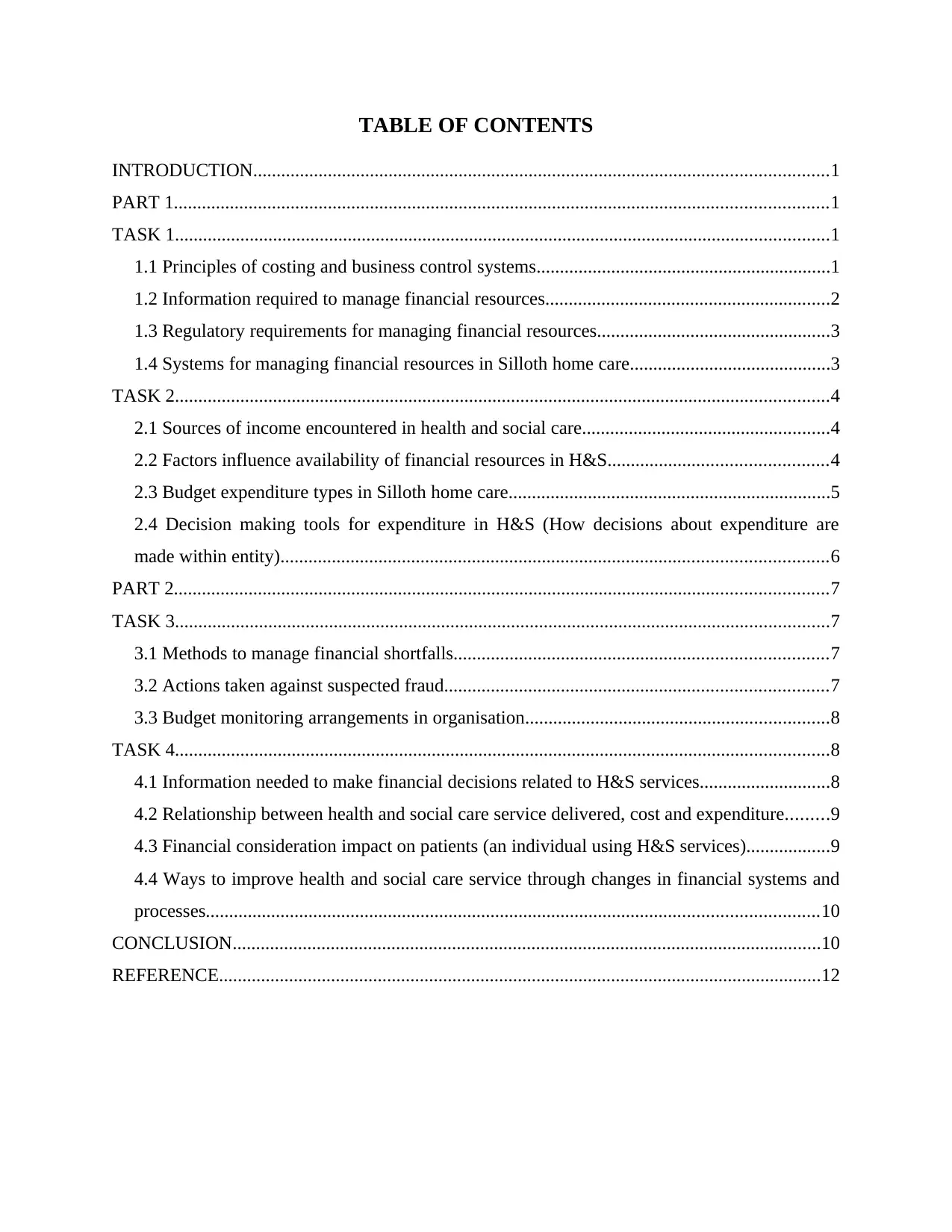
TABLE OF CONTENTS
INTRODUCTION...........................................................................................................................1
PART 1............................................................................................................................................1
TASK 1............................................................................................................................................1
1.1 Principles of costing and business control systems...............................................................1
1.2 Information required to manage financial resources.............................................................2
1.3 Regulatory requirements for managing financial resources..................................................3
1.4 Systems for managing financial resources in Silloth home care...........................................3
TASK 2............................................................................................................................................4
2.1 Sources of income encountered in health and social care.....................................................4
2.2 Factors influence availability of financial resources in H&S...............................................4
2.3 Budget expenditure types in Silloth home care.....................................................................5
2.4 Decision making tools for expenditure in H&S (How decisions about expenditure are
made within entity).....................................................................................................................6
PART 2............................................................................................................................................7
TASK 3............................................................................................................................................7
3.1 Methods to manage financial shortfalls................................................................................7
3.2 Actions taken against suspected fraud..................................................................................7
3.3 Budget monitoring arrangements in organisation.................................................................8
TASK 4............................................................................................................................................8
4.1 Information needed to make financial decisions related to H&S services............................8
4.2 Relationship between health and social care service delivered, cost and expenditure.........9
4.3 Financial consideration impact on patients (an individual using H&S services)..................9
4.4 Ways to improve health and social care service through changes in financial systems and
processes...................................................................................................................................10
CONCLUSION..............................................................................................................................10
REFERENCE.................................................................................................................................12
INTRODUCTION...........................................................................................................................1
PART 1............................................................................................................................................1
TASK 1............................................................................................................................................1
1.1 Principles of costing and business control systems...............................................................1
1.2 Information required to manage financial resources.............................................................2
1.3 Regulatory requirements for managing financial resources..................................................3
1.4 Systems for managing financial resources in Silloth home care...........................................3
TASK 2............................................................................................................................................4
2.1 Sources of income encountered in health and social care.....................................................4
2.2 Factors influence availability of financial resources in H&S...............................................4
2.3 Budget expenditure types in Silloth home care.....................................................................5
2.4 Decision making tools for expenditure in H&S (How decisions about expenditure are
made within entity).....................................................................................................................6
PART 2............................................................................................................................................7
TASK 3............................................................................................................................................7
3.1 Methods to manage financial shortfalls................................................................................7
3.2 Actions taken against suspected fraud..................................................................................7
3.3 Budget monitoring arrangements in organisation.................................................................8
TASK 4............................................................................................................................................8
4.1 Information needed to make financial decisions related to H&S services............................8
4.2 Relationship between health and social care service delivered, cost and expenditure.........9
4.3 Financial consideration impact on patients (an individual using H&S services)..................9
4.4 Ways to improve health and social care service through changes in financial systems and
processes...................................................................................................................................10
CONCLUSION..............................................................................................................................10
REFERENCE.................................................................................................................................12
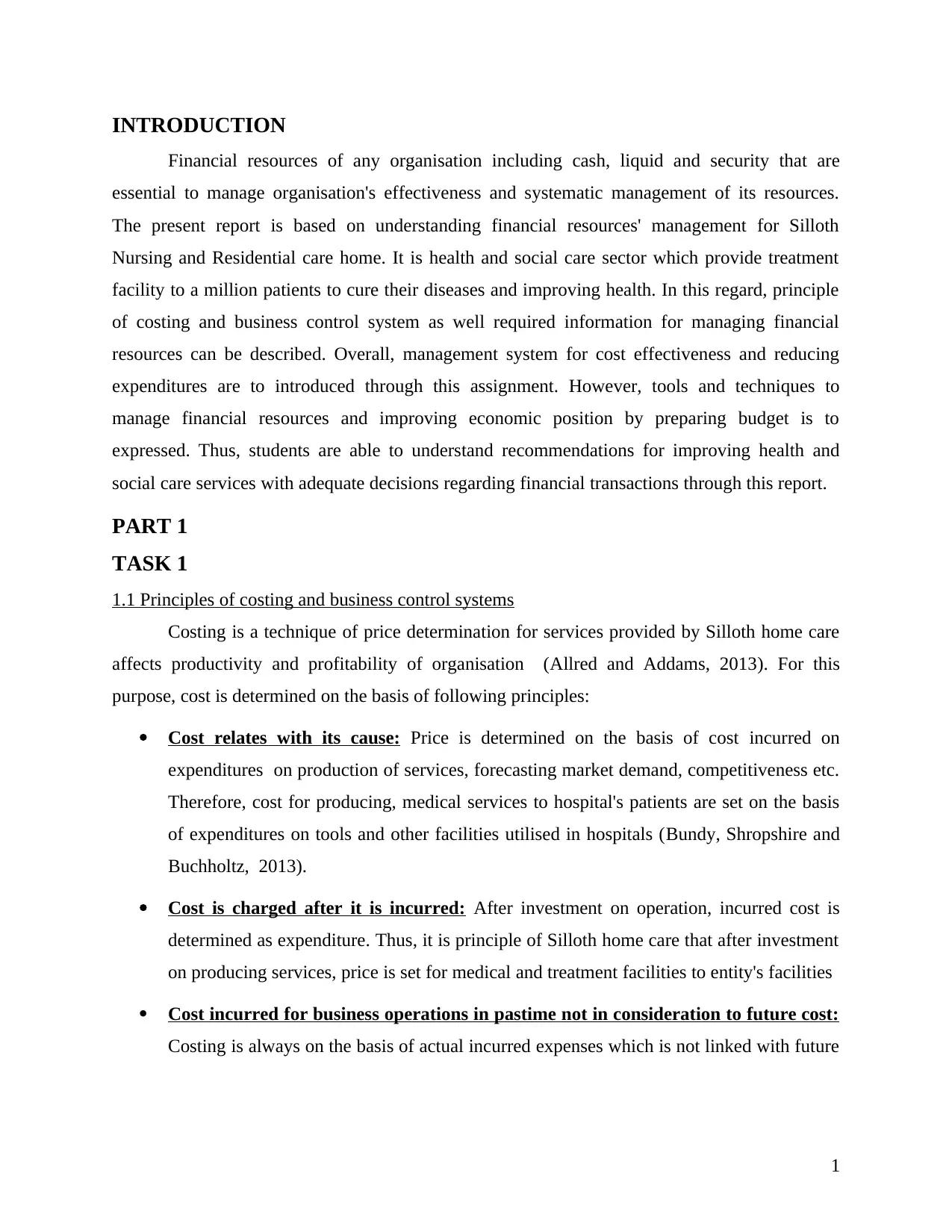
INTRODUCTION
Financial resources of any organisation including cash, liquid and security that are
essential to manage organisation's effectiveness and systematic management of its resources.
The present report is based on understanding financial resources' management for Silloth
Nursing and Residential care home. It is health and social care sector which provide treatment
facility to a million patients to cure their diseases and improving health. In this regard, principle
of costing and business control system as well required information for managing financial
resources can be described. Overall, management system for cost effectiveness and reducing
expenditures are to introduced through this assignment. However, tools and techniques to
manage financial resources and improving economic position by preparing budget is to
expressed. Thus, students are able to understand recommendations for improving health and
social care services with adequate decisions regarding financial transactions through this report.
PART 1
TASK 1
1.1 Principles of costing and business control systems
Costing is a technique of price determination for services provided by Silloth home care
affects productivity and profitability of organisation (Allred and Addams, 2013). For this
purpose, cost is determined on the basis of following principles:
Cost relates with its cause: Price is determined on the basis of cost incurred on
expenditures on production of services, forecasting market demand, competitiveness etc.
Therefore, cost for producing, medical services to hospital's patients are set on the basis
of expenditures on tools and other facilities utilised in hospitals (Bundy, Shropshire and
Buchholtz, 2013).
Cost is charged after it is incurred: After investment on operation, incurred cost is
determined as expenditure. Thus, it is principle of Silloth home care that after investment
on producing services, price is set for medical and treatment facilities to entity's facilities
Cost incurred for business operations in pastime not in consideration to future cost:
Costing is always on the basis of actual incurred expenses which is not linked with future
1
Financial resources of any organisation including cash, liquid and security that are
essential to manage organisation's effectiveness and systematic management of its resources.
The present report is based on understanding financial resources' management for Silloth
Nursing and Residential care home. It is health and social care sector which provide treatment
facility to a million patients to cure their diseases and improving health. In this regard, principle
of costing and business control system as well required information for managing financial
resources can be described. Overall, management system for cost effectiveness and reducing
expenditures are to introduced through this assignment. However, tools and techniques to
manage financial resources and improving economic position by preparing budget is to
expressed. Thus, students are able to understand recommendations for improving health and
social care services with adequate decisions regarding financial transactions through this report.
PART 1
TASK 1
1.1 Principles of costing and business control systems
Costing is a technique of price determination for services provided by Silloth home care
affects productivity and profitability of organisation (Allred and Addams, 2013). For this
purpose, cost is determined on the basis of following principles:
Cost relates with its cause: Price is determined on the basis of cost incurred on
expenditures on production of services, forecasting market demand, competitiveness etc.
Therefore, cost for producing, medical services to hospital's patients are set on the basis
of expenditures on tools and other facilities utilised in hospitals (Bundy, Shropshire and
Buchholtz, 2013).
Cost is charged after it is incurred: After investment on operation, incurred cost is
determined as expenditure. Thus, it is principle of Silloth home care that after investment
on producing services, price is set for medical and treatment facilities to entity's facilities
Cost incurred for business operations in pastime not in consideration to future cost:
Costing is always on the basis of actual incurred expenses which is not linked with future
1
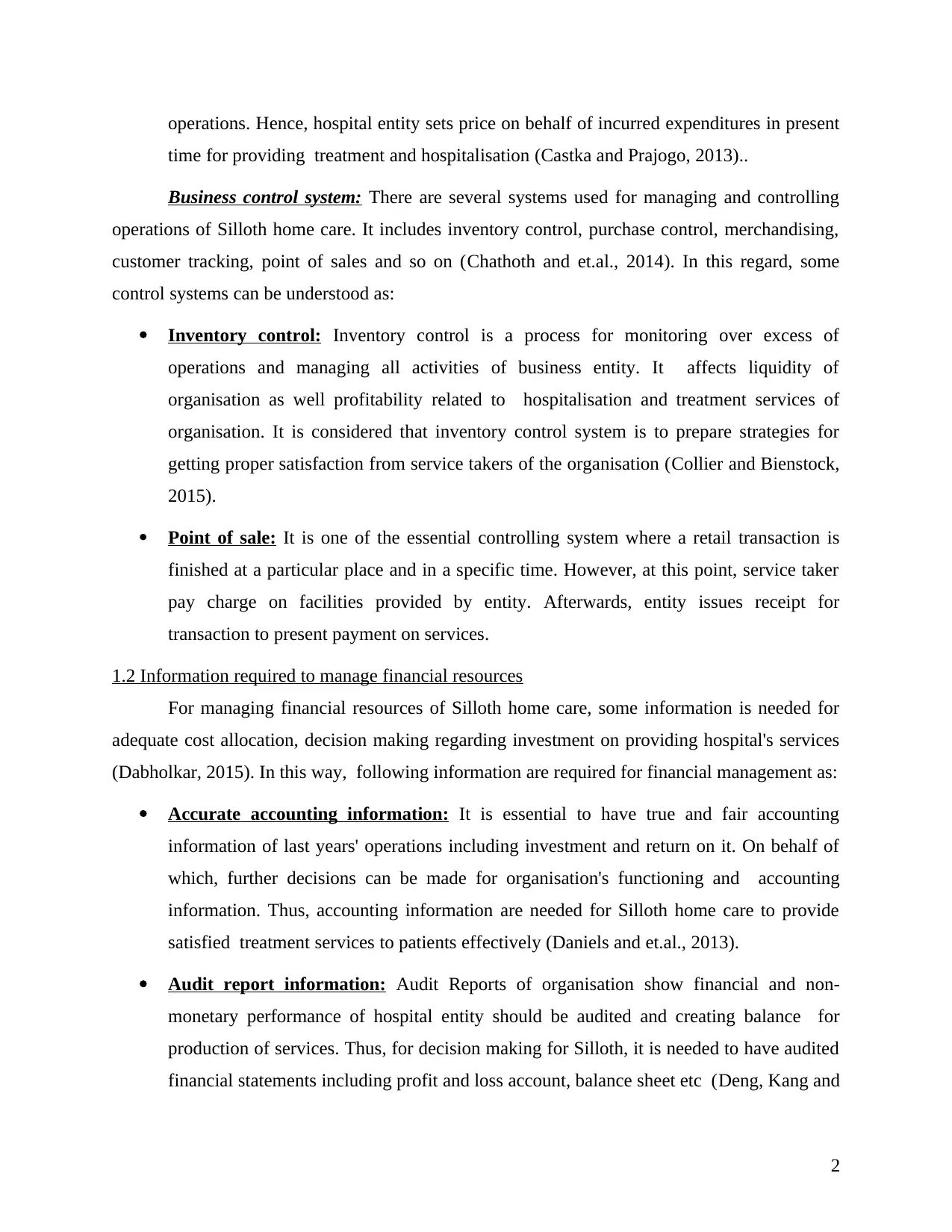
operations. Hence, hospital entity sets price on behalf of incurred expenditures in present
time for providing treatment and hospitalisation (Castka and Prajogo, 2013)..
Business control system: There are several systems used for managing and controlling
operations of Silloth home care. It includes inventory control, purchase control, merchandising,
customer tracking, point of sales and so on (Chathoth and et.al., 2014). In this regard, some
control systems can be understood as:
Inventory control: Inventory control is a process for monitoring over excess of
operations and managing all activities of business entity. It affects liquidity of
organisation as well profitability related to hospitalisation and treatment services of
organisation. It is considered that inventory control system is to prepare strategies for
getting proper satisfaction from service takers of the organisation (Collier and Bienstock,
2015).
Point of sale: It is one of the essential controlling system where a retail transaction is
finished at a particular place and in a specific time. However, at this point, service taker
pay charge on facilities provided by entity. Afterwards, entity issues receipt for
transaction to present payment on services.
1.2 Information required to manage financial resources
For managing financial resources of Silloth home care, some information is needed for
adequate cost allocation, decision making regarding investment on providing hospital's services
(Dabholkar, 2015). In this way, following information are required for financial management as:
Accurate accounting information: It is essential to have true and fair accounting
information of last years' operations including investment and return on it. On behalf of
which, further decisions can be made for organisation's functioning and accounting
information. Thus, accounting information are needed for Silloth home care to provide
satisfied treatment services to patients effectively (Daniels and et.al., 2013).
Audit report information: Audit Reports of organisation show financial and non-
monetary performance of hospital entity should be audited and creating balance for
production of services. Thus, for decision making for Silloth, it is needed to have audited
financial statements including profit and loss account, balance sheet etc (Deng, Kang and
2
time for providing treatment and hospitalisation (Castka and Prajogo, 2013)..
Business control system: There are several systems used for managing and controlling
operations of Silloth home care. It includes inventory control, purchase control, merchandising,
customer tracking, point of sales and so on (Chathoth and et.al., 2014). In this regard, some
control systems can be understood as:
Inventory control: Inventory control is a process for monitoring over excess of
operations and managing all activities of business entity. It affects liquidity of
organisation as well profitability related to hospitalisation and treatment services of
organisation. It is considered that inventory control system is to prepare strategies for
getting proper satisfaction from service takers of the organisation (Collier and Bienstock,
2015).
Point of sale: It is one of the essential controlling system where a retail transaction is
finished at a particular place and in a specific time. However, at this point, service taker
pay charge on facilities provided by entity. Afterwards, entity issues receipt for
transaction to present payment on services.
1.2 Information required to manage financial resources
For managing financial resources of Silloth home care, some information is needed for
adequate cost allocation, decision making regarding investment on providing hospital's services
(Dabholkar, 2015). In this way, following information are required for financial management as:
Accurate accounting information: It is essential to have true and fair accounting
information of last years' operations including investment and return on it. On behalf of
which, further decisions can be made for organisation's functioning and accounting
information. Thus, accounting information are needed for Silloth home care to provide
satisfied treatment services to patients effectively (Daniels and et.al., 2013).
Audit report information: Audit Reports of organisation show financial and non-
monetary performance of hospital entity should be audited and creating balance for
production of services. Thus, for decision making for Silloth, it is needed to have audited
financial statements including profit and loss account, balance sheet etc (Deng, Kang and
2
Secure Best Marks with AI Grader
Need help grading? Try our AI Grader for instant feedback on your assignments.
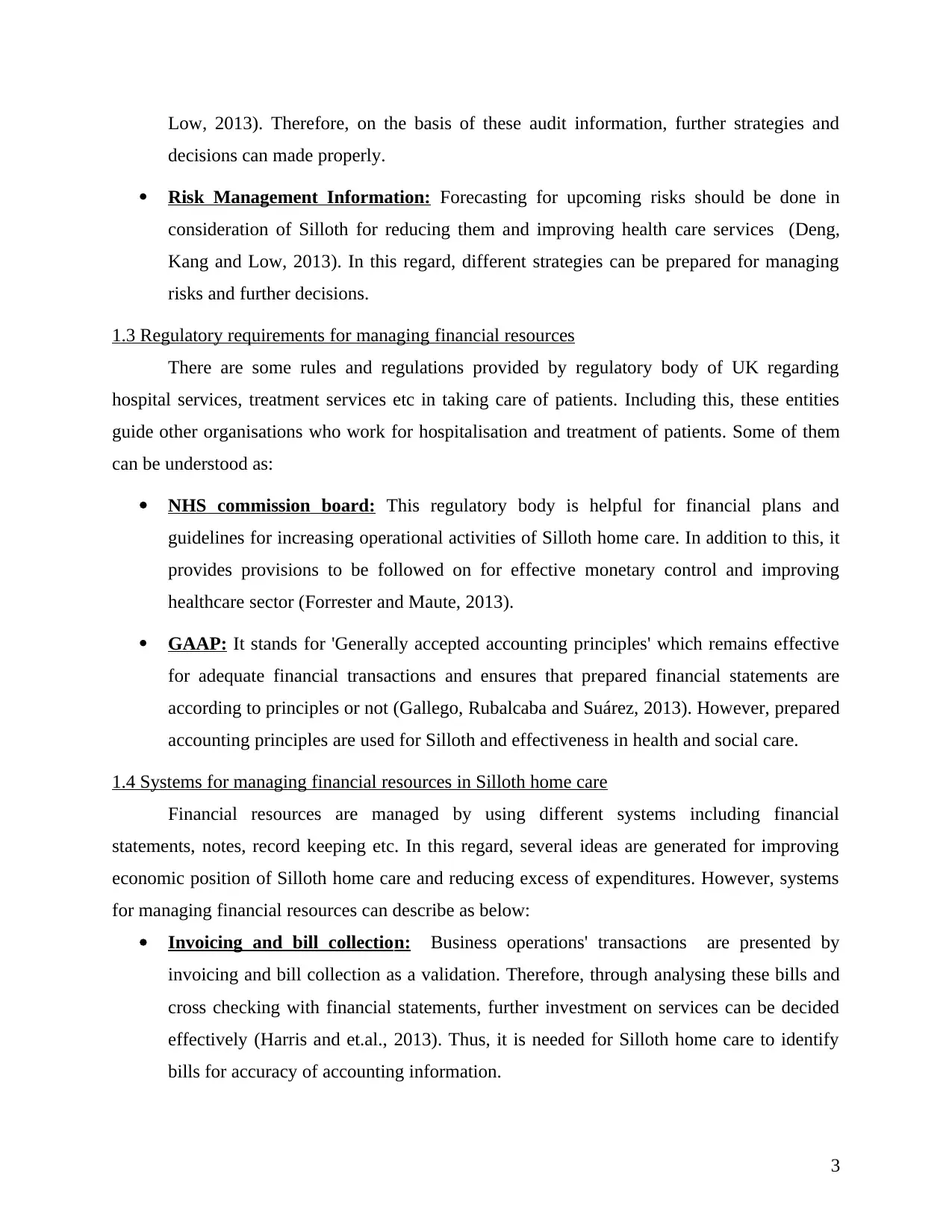
Low, 2013). Therefore, on the basis of these audit information, further strategies and
decisions can made properly.
Risk Management Information: Forecasting for upcoming risks should be done in
consideration of Silloth for reducing them and improving health care services (Deng,
Kang and Low, 2013). In this regard, different strategies can be prepared for managing
risks and further decisions.
1.3 Regulatory requirements for managing financial resources
There are some rules and regulations provided by regulatory body of UK regarding
hospital services, treatment services etc in taking care of patients. Including this, these entities
guide other organisations who work for hospitalisation and treatment of patients. Some of them
can be understood as:
NHS commission board: This regulatory body is helpful for financial plans and
guidelines for increasing operational activities of Silloth home care. In addition to this, it
provides provisions to be followed on for effective monetary control and improving
healthcare sector (Forrester and Maute, 2013).
GAAP: It stands for 'Generally accepted accounting principles' which remains effective
for adequate financial transactions and ensures that prepared financial statements are
according to principles or not (Gallego, Rubalcaba and Suárez, 2013). However, prepared
accounting principles are used for Silloth and effectiveness in health and social care.
1.4 Systems for managing financial resources in Silloth home care
Financial resources are managed by using different systems including financial
statements, notes, record keeping etc. In this regard, several ideas are generated for improving
economic position of Silloth home care and reducing excess of expenditures. However, systems
for managing financial resources can describe as below:
Invoicing and bill collection: Business operations' transactions are presented by
invoicing and bill collection as a validation. Therefore, through analysing these bills and
cross checking with financial statements, further investment on services can be decided
effectively (Harris and et.al., 2013). Thus, it is needed for Silloth home care to identify
bills for accuracy of accounting information.
3
decisions can made properly.
Risk Management Information: Forecasting for upcoming risks should be done in
consideration of Silloth for reducing them and improving health care services (Deng,
Kang and Low, 2013). In this regard, different strategies can be prepared for managing
risks and further decisions.
1.3 Regulatory requirements for managing financial resources
There are some rules and regulations provided by regulatory body of UK regarding
hospital services, treatment services etc in taking care of patients. Including this, these entities
guide other organisations who work for hospitalisation and treatment of patients. Some of them
can be understood as:
NHS commission board: This regulatory body is helpful for financial plans and
guidelines for increasing operational activities of Silloth home care. In addition to this, it
provides provisions to be followed on for effective monetary control and improving
healthcare sector (Forrester and Maute, 2013).
GAAP: It stands for 'Generally accepted accounting principles' which remains effective
for adequate financial transactions and ensures that prepared financial statements are
according to principles or not (Gallego, Rubalcaba and Suárez, 2013). However, prepared
accounting principles are used for Silloth and effectiveness in health and social care.
1.4 Systems for managing financial resources in Silloth home care
Financial resources are managed by using different systems including financial
statements, notes, record keeping etc. In this regard, several ideas are generated for improving
economic position of Silloth home care and reducing excess of expenditures. However, systems
for managing financial resources can describe as below:
Invoicing and bill collection: Business operations' transactions are presented by
invoicing and bill collection as a validation. Therefore, through analysing these bills and
cross checking with financial statements, further investment on services can be decided
effectively (Harris and et.al., 2013). Thus, it is needed for Silloth home care to identify
bills for accuracy of accounting information.
3
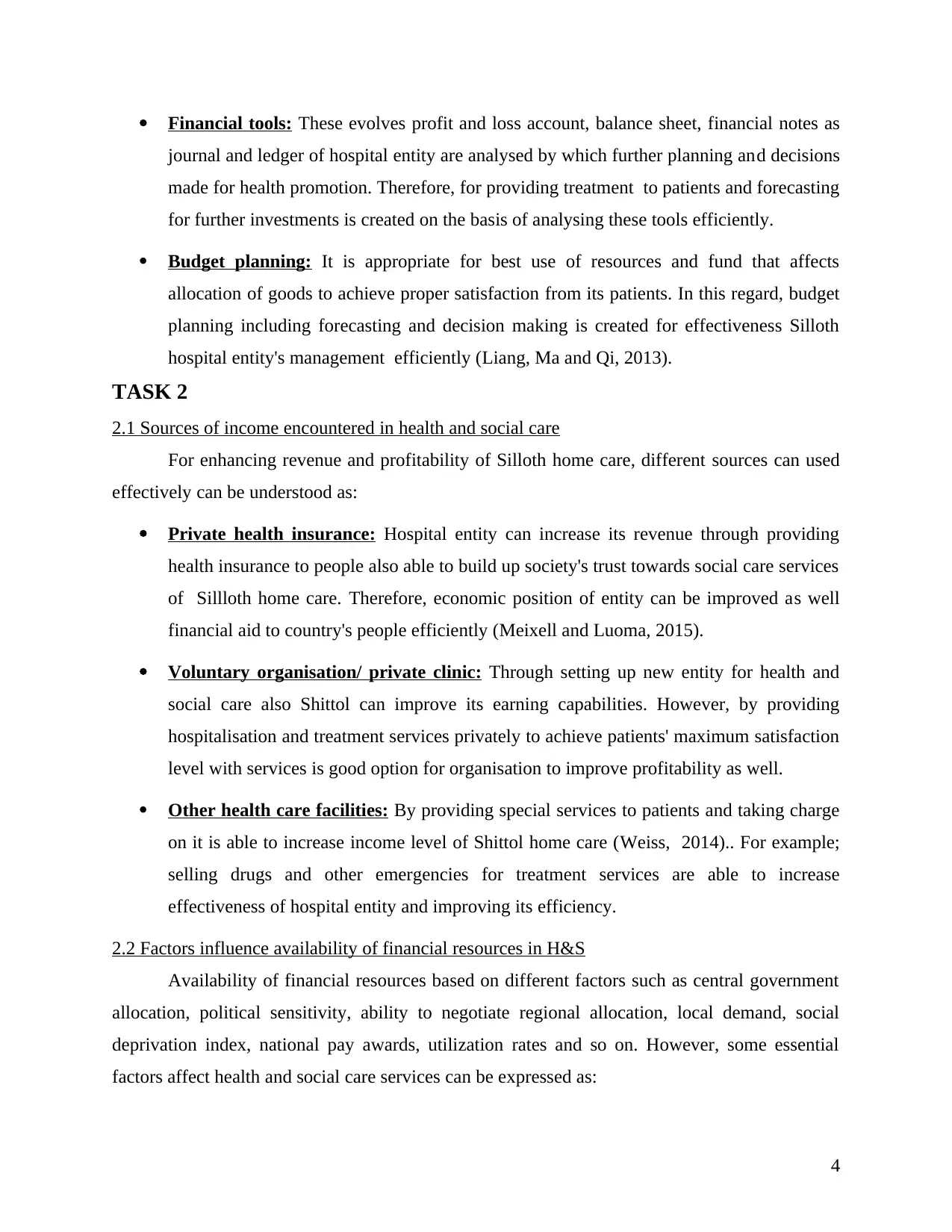
Financial tools: These evolves profit and loss account, balance sheet, financial notes as
journal and ledger of hospital entity are analysed by which further planning and decisions
made for health promotion. Therefore, for providing treatment to patients and forecasting
for further investments is created on the basis of analysing these tools efficiently.
Budget planning: It is appropriate for best use of resources and fund that affects
allocation of goods to achieve proper satisfaction from its patients. In this regard, budget
planning including forecasting and decision making is created for effectiveness Silloth
hospital entity's management efficiently (Liang, Ma and Qi, 2013).
TASK 2
2.1 Sources of income encountered in health and social care
For enhancing revenue and profitability of Silloth home care, different sources can used
effectively can be understood as:
Private health insurance: Hospital entity can increase its revenue through providing
health insurance to people also able to build up society's trust towards social care services
of Sillloth home care. Therefore, economic position of entity can be improved as well
financial aid to country's people efficiently (Meixell and Luoma, 2015).
Voluntary organisation/ private clinic: Through setting up new entity for health and
social care also Shittol can improve its earning capabilities. However, by providing
hospitalisation and treatment services privately to achieve patients' maximum satisfaction
level with services is good option for organisation to improve profitability as well.
Other health care facilities: By providing special services to patients and taking charge
on it is able to increase income level of Shittol home care (Weiss, 2014).. For example;
selling drugs and other emergencies for treatment services are able to increase
effectiveness of hospital entity and improving its efficiency.
2.2 Factors influence availability of financial resources in H&S
Availability of financial resources based on different factors such as central government
allocation, political sensitivity, ability to negotiate regional allocation, local demand, social
deprivation index, national pay awards, utilization rates and so on. However, some essential
factors affect health and social care services can be expressed as:
4
journal and ledger of hospital entity are analysed by which further planning and decisions
made for health promotion. Therefore, for providing treatment to patients and forecasting
for further investments is created on the basis of analysing these tools efficiently.
Budget planning: It is appropriate for best use of resources and fund that affects
allocation of goods to achieve proper satisfaction from its patients. In this regard, budget
planning including forecasting and decision making is created for effectiveness Silloth
hospital entity's management efficiently (Liang, Ma and Qi, 2013).
TASK 2
2.1 Sources of income encountered in health and social care
For enhancing revenue and profitability of Silloth home care, different sources can used
effectively can be understood as:
Private health insurance: Hospital entity can increase its revenue through providing
health insurance to people also able to build up society's trust towards social care services
of Sillloth home care. Therefore, economic position of entity can be improved as well
financial aid to country's people efficiently (Meixell and Luoma, 2015).
Voluntary organisation/ private clinic: Through setting up new entity for health and
social care also Shittol can improve its earning capabilities. However, by providing
hospitalisation and treatment services privately to achieve patients' maximum satisfaction
level with services is good option for organisation to improve profitability as well.
Other health care facilities: By providing special services to patients and taking charge
on it is able to increase income level of Shittol home care (Weiss, 2014).. For example;
selling drugs and other emergencies for treatment services are able to increase
effectiveness of hospital entity and improving its efficiency.
2.2 Factors influence availability of financial resources in H&S
Availability of financial resources based on different factors such as central government
allocation, political sensitivity, ability to negotiate regional allocation, local demand, social
deprivation index, national pay awards, utilization rates and so on. However, some essential
factors affect health and social care services can be expressed as:
4
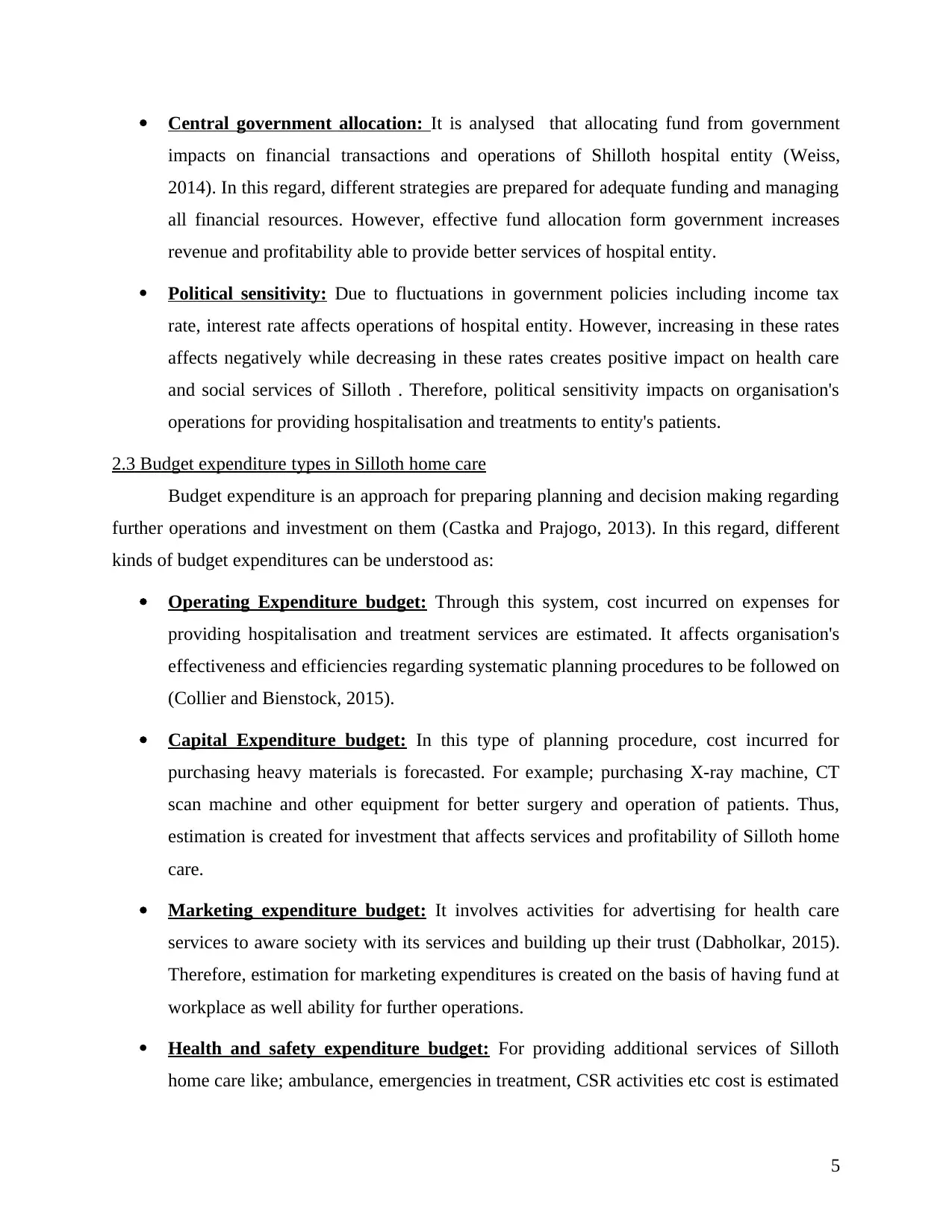
Central government allocation: It is analysed that allocating fund from government
impacts on financial transactions and operations of Shilloth hospital entity (Weiss,
2014). In this regard, different strategies are prepared for adequate funding and managing
all financial resources. However, effective fund allocation form government increases
revenue and profitability able to provide better services of hospital entity.
Political sensitivity: Due to fluctuations in government policies including income tax
rate, interest rate affects operations of hospital entity. However, increasing in these rates
affects negatively while decreasing in these rates creates positive impact on health care
and social services of Silloth . Therefore, political sensitivity impacts on organisation's
operations for providing hospitalisation and treatments to entity's patients.
2.3 Budget expenditure types in Silloth home care
Budget expenditure is an approach for preparing planning and decision making regarding
further operations and investment on them (Castka and Prajogo, 2013). In this regard, different
kinds of budget expenditures can be understood as:
Operating Expenditure budget: Through this system, cost incurred on expenses for
providing hospitalisation and treatment services are estimated. It affects organisation's
effectiveness and efficiencies regarding systematic planning procedures to be followed on
(Collier and Bienstock, 2015).
Capital Expenditure budget: In this type of planning procedure, cost incurred for
purchasing heavy materials is forecasted. For example; purchasing X-ray machine, CT
scan machine and other equipment for better surgery and operation of patients. Thus,
estimation is created for investment that affects services and profitability of Silloth home
care.
Marketing expenditure budget: It involves activities for advertising for health care
services to aware society with its services and building up their trust (Dabholkar, 2015).
Therefore, estimation for marketing expenditures is created on the basis of having fund at
workplace as well ability for further operations.
Health and safety expenditure budget: For providing additional services of Silloth
home care like; ambulance, emergencies in treatment, CSR activities etc cost is estimated
5
impacts on financial transactions and operations of Shilloth hospital entity (Weiss,
2014). In this regard, different strategies are prepared for adequate funding and managing
all financial resources. However, effective fund allocation form government increases
revenue and profitability able to provide better services of hospital entity.
Political sensitivity: Due to fluctuations in government policies including income tax
rate, interest rate affects operations of hospital entity. However, increasing in these rates
affects negatively while decreasing in these rates creates positive impact on health care
and social services of Silloth . Therefore, political sensitivity impacts on organisation's
operations for providing hospitalisation and treatments to entity's patients.
2.3 Budget expenditure types in Silloth home care
Budget expenditure is an approach for preparing planning and decision making regarding
further operations and investment on them (Castka and Prajogo, 2013). In this regard, different
kinds of budget expenditures can be understood as:
Operating Expenditure budget: Through this system, cost incurred on expenses for
providing hospitalisation and treatment services are estimated. It affects organisation's
effectiveness and efficiencies regarding systematic planning procedures to be followed on
(Collier and Bienstock, 2015).
Capital Expenditure budget: In this type of planning procedure, cost incurred for
purchasing heavy materials is forecasted. For example; purchasing X-ray machine, CT
scan machine and other equipment for better surgery and operation of patients. Thus,
estimation is created for investment that affects services and profitability of Silloth home
care.
Marketing expenditure budget: It involves activities for advertising for health care
services to aware society with its services and building up their trust (Dabholkar, 2015).
Therefore, estimation for marketing expenditures is created on the basis of having fund at
workplace as well ability for further operations.
Health and safety expenditure budget: For providing additional services of Silloth
home care like; ambulance, emergencies in treatment, CSR activities etc cost is estimated
5
Paraphrase This Document
Need a fresh take? Get an instant paraphrase of this document with our AI Paraphraser
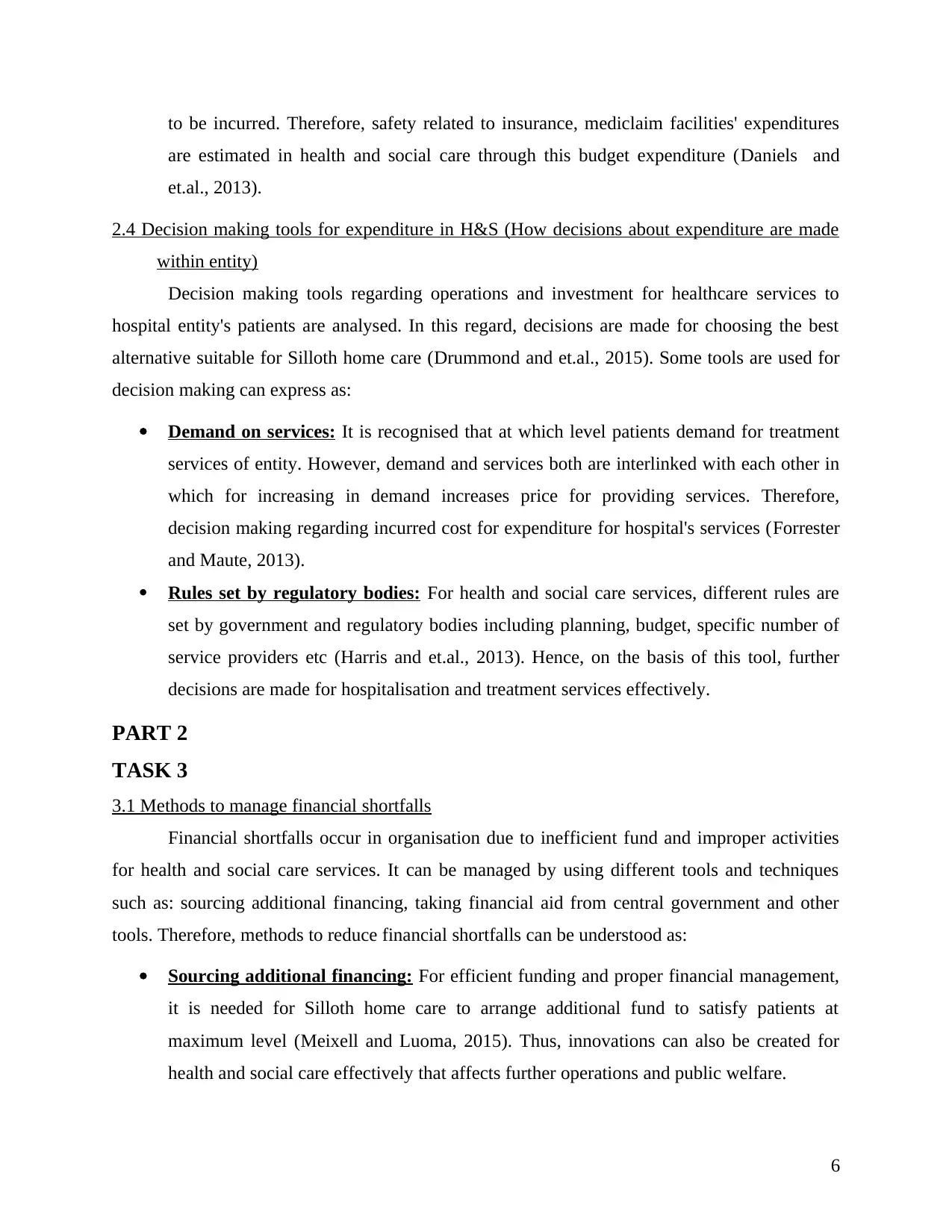
to be incurred. Therefore, safety related to insurance, mediclaim facilities' expenditures
are estimated in health and social care through this budget expenditure (Daniels and
et.al., 2013).
2.4 Decision making tools for expenditure in H&S (How decisions about expenditure are made
within entity)
Decision making tools regarding operations and investment for healthcare services to
hospital entity's patients are analysed. In this regard, decisions are made for choosing the best
alternative suitable for Silloth home care (Drummond and et.al., 2015). Some tools are used for
decision making can express as:
Demand on services: It is recognised that at which level patients demand for treatment
services of entity. However, demand and services both are interlinked with each other in
which for increasing in demand increases price for providing services. Therefore,
decision making regarding incurred cost for expenditure for hospital's services (Forrester
and Maute, 2013).
Rules set by regulatory bodies: For health and social care services, different rules are
set by government and regulatory bodies including planning, budget, specific number of
service providers etc (Harris and et.al., 2013). Hence, on the basis of this tool, further
decisions are made for hospitalisation and treatment services effectively.
PART 2
TASK 3
3.1 Methods to manage financial shortfalls
Financial shortfalls occur in organisation due to inefficient fund and improper activities
for health and social care services. It can be managed by using different tools and techniques
such as: sourcing additional financing, taking financial aid from central government and other
tools. Therefore, methods to reduce financial shortfalls can be understood as:
Sourcing additional financing: For efficient funding and proper financial management,
it is needed for Silloth home care to arrange additional fund to satisfy patients at
maximum level (Meixell and Luoma, 2015). Thus, innovations can also be created for
health and social care effectively that affects further operations and public welfare.
6
are estimated in health and social care through this budget expenditure (Daniels and
et.al., 2013).
2.4 Decision making tools for expenditure in H&S (How decisions about expenditure are made
within entity)
Decision making tools regarding operations and investment for healthcare services to
hospital entity's patients are analysed. In this regard, decisions are made for choosing the best
alternative suitable for Silloth home care (Drummond and et.al., 2015). Some tools are used for
decision making can express as:
Demand on services: It is recognised that at which level patients demand for treatment
services of entity. However, demand and services both are interlinked with each other in
which for increasing in demand increases price for providing services. Therefore,
decision making regarding incurred cost for expenditure for hospital's services (Forrester
and Maute, 2013).
Rules set by regulatory bodies: For health and social care services, different rules are
set by government and regulatory bodies including planning, budget, specific number of
service providers etc (Harris and et.al., 2013). Hence, on the basis of this tool, further
decisions are made for hospitalisation and treatment services effectively.
PART 2
TASK 3
3.1 Methods to manage financial shortfalls
Financial shortfalls occur in organisation due to inefficient fund and improper activities
for health and social care services. It can be managed by using different tools and techniques
such as: sourcing additional financing, taking financial aid from central government and other
tools. Therefore, methods to reduce financial shortfalls can be understood as:
Sourcing additional financing: For efficient funding and proper financial management,
it is needed for Silloth home care to arrange additional fund to satisfy patients at
maximum level (Meixell and Luoma, 2015). Thus, innovations can also be created for
health and social care effectively that affects further operations and public welfare.
6
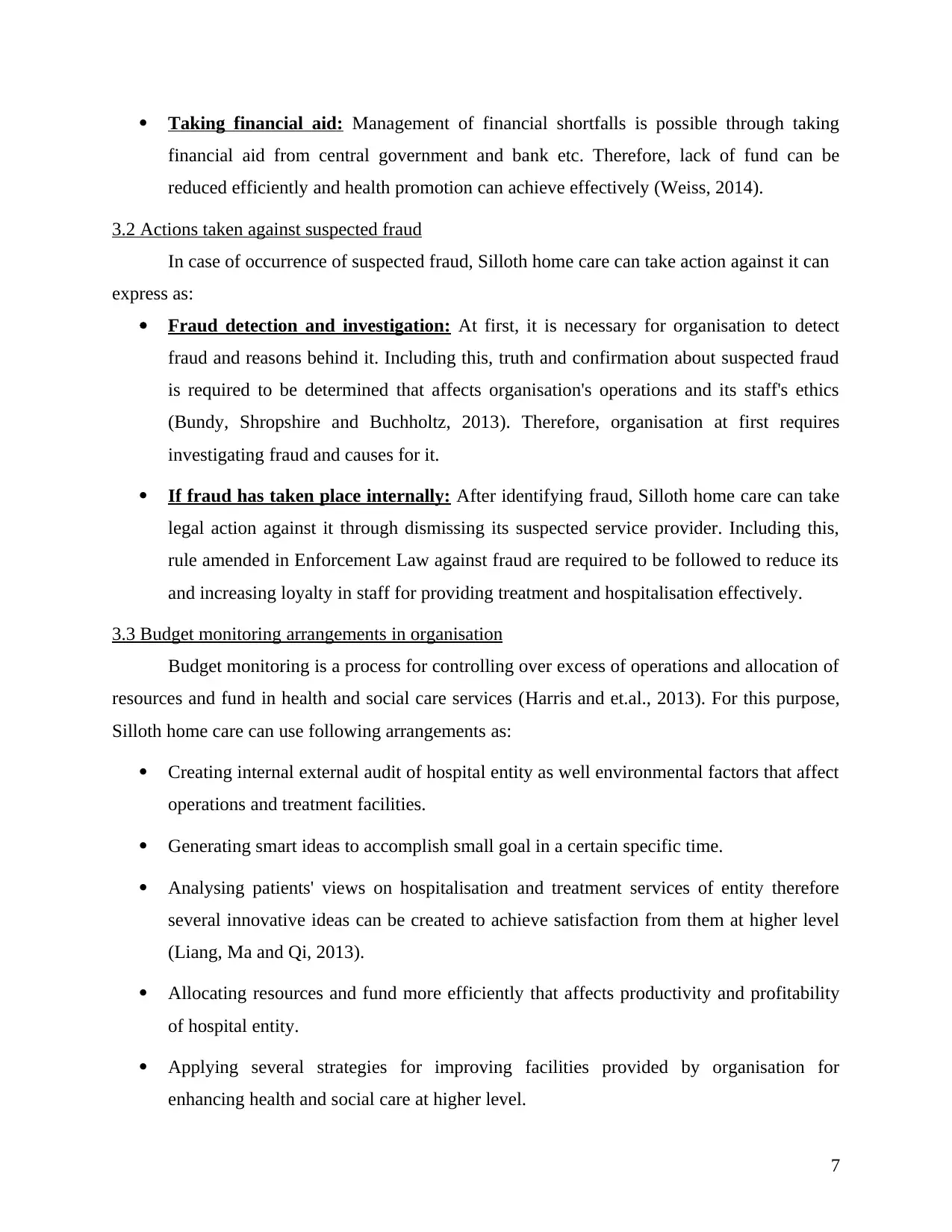
Taking financial aid: Management of financial shortfalls is possible through taking
financial aid from central government and bank etc. Therefore, lack of fund can be
reduced efficiently and health promotion can achieve effectively (Weiss, 2014).
3.2 Actions taken against suspected fraud
In case of occurrence of suspected fraud, Silloth home care can take action against it can
express as:
Fraud detection and investigation: At first, it is necessary for organisation to detect
fraud and reasons behind it. Including this, truth and confirmation about suspected fraud
is required to be determined that affects organisation's operations and its staff's ethics
(Bundy, Shropshire and Buchholtz, 2013). Therefore, organisation at first requires
investigating fraud and causes for it.
If fraud has taken place internally: After identifying fraud, Silloth home care can take
legal action against it through dismissing its suspected service provider. Including this,
rule amended in Enforcement Law against fraud are required to be followed to reduce its
and increasing loyalty in staff for providing treatment and hospitalisation effectively.
3.3 Budget monitoring arrangements in organisation
Budget monitoring is a process for controlling over excess of operations and allocation of
resources and fund in health and social care services (Harris and et.al., 2013). For this purpose,
Silloth home care can use following arrangements as:
Creating internal external audit of hospital entity as well environmental factors that affect
operations and treatment facilities.
Generating smart ideas to accomplish small goal in a certain specific time.
Analysing patients' views on hospitalisation and treatment services of entity therefore
several innovative ideas can be created to achieve satisfaction from them at higher level
(Liang, Ma and Qi, 2013).
Allocating resources and fund more efficiently that affects productivity and profitability
of hospital entity.
Applying several strategies for improving facilities provided by organisation for
enhancing health and social care at higher level.
7
financial aid from central government and bank etc. Therefore, lack of fund can be
reduced efficiently and health promotion can achieve effectively (Weiss, 2014).
3.2 Actions taken against suspected fraud
In case of occurrence of suspected fraud, Silloth home care can take action against it can
express as:
Fraud detection and investigation: At first, it is necessary for organisation to detect
fraud and reasons behind it. Including this, truth and confirmation about suspected fraud
is required to be determined that affects organisation's operations and its staff's ethics
(Bundy, Shropshire and Buchholtz, 2013). Therefore, organisation at first requires
investigating fraud and causes for it.
If fraud has taken place internally: After identifying fraud, Silloth home care can take
legal action against it through dismissing its suspected service provider. Including this,
rule amended in Enforcement Law against fraud are required to be followed to reduce its
and increasing loyalty in staff for providing treatment and hospitalisation effectively.
3.3 Budget monitoring arrangements in organisation
Budget monitoring is a process for controlling over excess of operations and allocation of
resources and fund in health and social care services (Harris and et.al., 2013). For this purpose,
Silloth home care can use following arrangements as:
Creating internal external audit of hospital entity as well environmental factors that affect
operations and treatment facilities.
Generating smart ideas to accomplish small goal in a certain specific time.
Analysing patients' views on hospitalisation and treatment services of entity therefore
several innovative ideas can be created to achieve satisfaction from them at higher level
(Liang, Ma and Qi, 2013).
Allocating resources and fund more efficiently that affects productivity and profitability
of hospital entity.
Applying several strategies for improving facilities provided by organisation for
enhancing health and social care at higher level.
7
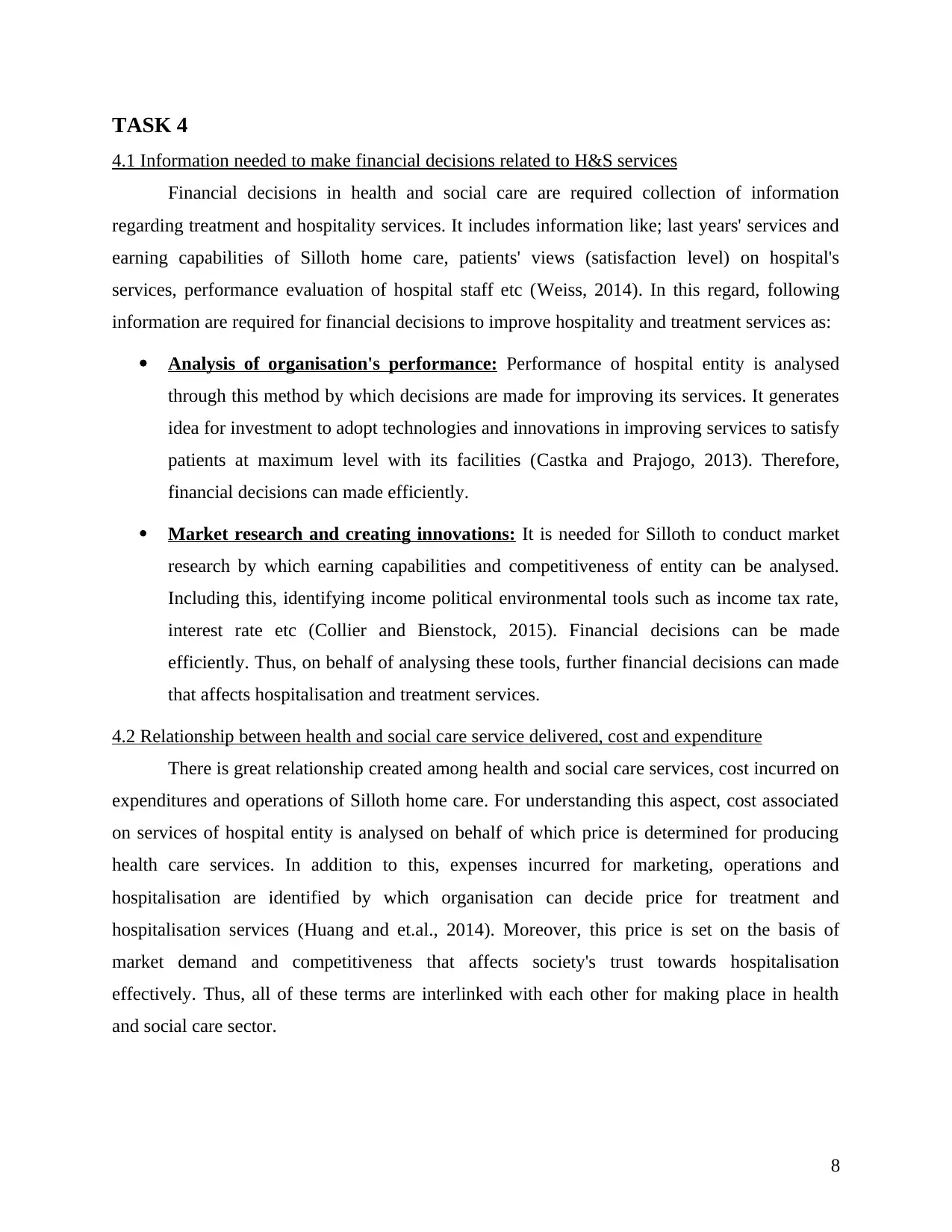
TASK 4
4.1 Information needed to make financial decisions related to H&S services
Financial decisions in health and social care are required collection of information
regarding treatment and hospitality services. It includes information like; last years' services and
earning capabilities of Silloth home care, patients' views (satisfaction level) on hospital's
services, performance evaluation of hospital staff etc (Weiss, 2014). In this regard, following
information are required for financial decisions to improve hospitality and treatment services as:
Analysis of organisation's performance: Performance of hospital entity is analysed
through this method by which decisions are made for improving its services. It generates
idea for investment to adopt technologies and innovations in improving services to satisfy
patients at maximum level with its facilities (Castka and Prajogo, 2013). Therefore,
financial decisions can made efficiently.
Market research and creating innovations: It is needed for Silloth to conduct market
research by which earning capabilities and competitiveness of entity can be analysed.
Including this, identifying income political environmental tools such as income tax rate,
interest rate etc (Collier and Bienstock, 2015). Financial decisions can be made
efficiently. Thus, on behalf of analysing these tools, further financial decisions can made
that affects hospitalisation and treatment services.
4.2 Relationship between health and social care service delivered, cost and expenditure
There is great relationship created among health and social care services, cost incurred on
expenditures and operations of Silloth home care. For understanding this aspect, cost associated
on services of hospital entity is analysed on behalf of which price is determined for producing
health care services. In addition to this, expenses incurred for marketing, operations and
hospitalisation are identified by which organisation can decide price for treatment and
hospitalisation services (Huang and et.al., 2014). Moreover, this price is set on the basis of
market demand and competitiveness that affects society's trust towards hospitalisation
effectively. Thus, all of these terms are interlinked with each other for making place in health
and social care sector.
8
4.1 Information needed to make financial decisions related to H&S services
Financial decisions in health and social care are required collection of information
regarding treatment and hospitality services. It includes information like; last years' services and
earning capabilities of Silloth home care, patients' views (satisfaction level) on hospital's
services, performance evaluation of hospital staff etc (Weiss, 2014). In this regard, following
information are required for financial decisions to improve hospitality and treatment services as:
Analysis of organisation's performance: Performance of hospital entity is analysed
through this method by which decisions are made for improving its services. It generates
idea for investment to adopt technologies and innovations in improving services to satisfy
patients at maximum level with its facilities (Castka and Prajogo, 2013). Therefore,
financial decisions can made efficiently.
Market research and creating innovations: It is needed for Silloth to conduct market
research by which earning capabilities and competitiveness of entity can be analysed.
Including this, identifying income political environmental tools such as income tax rate,
interest rate etc (Collier and Bienstock, 2015). Financial decisions can be made
efficiently. Thus, on behalf of analysing these tools, further financial decisions can made
that affects hospitalisation and treatment services.
4.2 Relationship between health and social care service delivered, cost and expenditure
There is great relationship created among health and social care services, cost incurred on
expenditures and operations of Silloth home care. For understanding this aspect, cost associated
on services of hospital entity is analysed on behalf of which price is determined for producing
health care services. In addition to this, expenses incurred for marketing, operations and
hospitalisation are identified by which organisation can decide price for treatment and
hospitalisation services (Huang and et.al., 2014). Moreover, this price is set on the basis of
market demand and competitiveness that affects society's trust towards hospitalisation
effectively. Thus, all of these terms are interlinked with each other for making place in health
and social care sector.
8
Secure Best Marks with AI Grader
Need help grading? Try our AI Grader for instant feedback on your assignments.
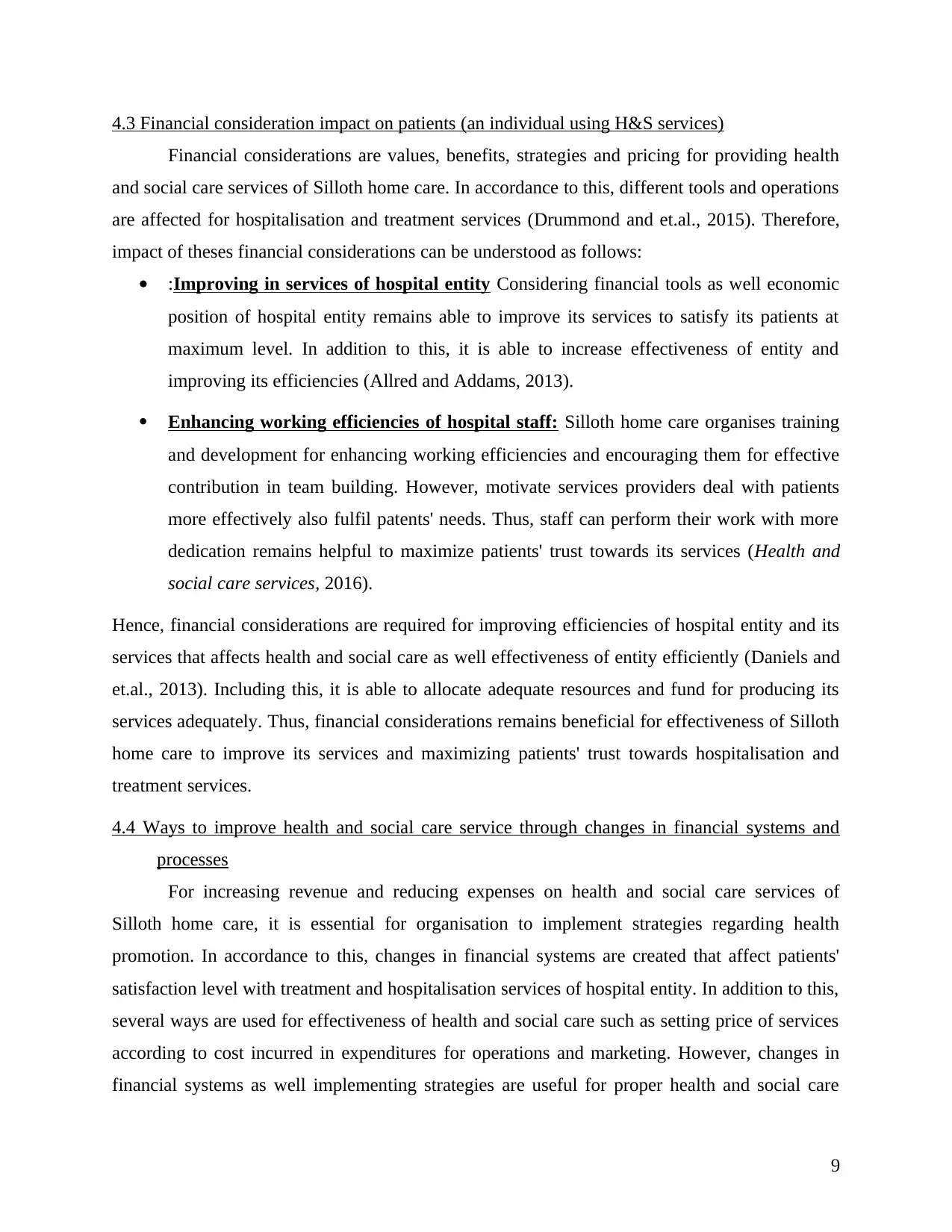
4.3 Financial consideration impact on patients (an individual using H&S services)
Financial considerations are values, benefits, strategies and pricing for providing health
and social care services of Silloth home care. In accordance to this, different tools and operations
are affected for hospitalisation and treatment services (Drummond and et.al., 2015). Therefore,
impact of theses financial considerations can be understood as follows:
:Improving in services of hospital entity Considering financial tools as well economic
position of hospital entity remains able to improve its services to satisfy its patients at
maximum level. In addition to this, it is able to increase effectiveness of entity and
improving its efficiencies (Allred and Addams, 2013).
Enhancing working efficiencies of hospital staff: Silloth home care organises training
and development for enhancing working efficiencies and encouraging them for effective
contribution in team building. However, motivate services providers deal with patients
more effectively also fulfil patents' needs. Thus, staff can perform their work with more
dedication remains helpful to maximize patients' trust towards its services (Health and
social care services, 2016).
Hence, financial considerations are required for improving efficiencies of hospital entity and its
services that affects health and social care as well effectiveness of entity efficiently (Daniels and
et.al., 2013). Including this, it is able to allocate adequate resources and fund for producing its
services adequately. Thus, financial considerations remains beneficial for effectiveness of Silloth
home care to improve its services and maximizing patients' trust towards hospitalisation and
treatment services.
4.4 Ways to improve health and social care service through changes in financial systems and
processes
For increasing revenue and reducing expenses on health and social care services of
Silloth home care, it is essential for organisation to implement strategies regarding health
promotion. In accordance to this, changes in financial systems are created that affect patients'
satisfaction level with treatment and hospitalisation services of hospital entity. In addition to this,
several ways are used for effectiveness of health and social care such as setting price of services
according to cost incurred in expenditures for operations and marketing. However, changes in
financial systems as well implementing strategies are useful for proper health and social care
9
Financial considerations are values, benefits, strategies and pricing for providing health
and social care services of Silloth home care. In accordance to this, different tools and operations
are affected for hospitalisation and treatment services (Drummond and et.al., 2015). Therefore,
impact of theses financial considerations can be understood as follows:
:Improving in services of hospital entity Considering financial tools as well economic
position of hospital entity remains able to improve its services to satisfy its patients at
maximum level. In addition to this, it is able to increase effectiveness of entity and
improving its efficiencies (Allred and Addams, 2013).
Enhancing working efficiencies of hospital staff: Silloth home care organises training
and development for enhancing working efficiencies and encouraging them for effective
contribution in team building. However, motivate services providers deal with patients
more effectively also fulfil patents' needs. Thus, staff can perform their work with more
dedication remains helpful to maximize patients' trust towards its services (Health and
social care services, 2016).
Hence, financial considerations are required for improving efficiencies of hospital entity and its
services that affects health and social care as well effectiveness of entity efficiently (Daniels and
et.al., 2013). Including this, it is able to allocate adequate resources and fund for producing its
services adequately. Thus, financial considerations remains beneficial for effectiveness of Silloth
home care to improve its services and maximizing patients' trust towards hospitalisation and
treatment services.
4.4 Ways to improve health and social care service through changes in financial systems and
processes
For increasing revenue and reducing expenses on health and social care services of
Silloth home care, it is essential for organisation to implement strategies regarding health
promotion. In accordance to this, changes in financial systems are created that affect patients'
satisfaction level with treatment and hospitalisation services of hospital entity. In addition to this,
several ways are used for effectiveness of health and social care such as setting price of services
according to cost incurred in expenditures for operations and marketing. However, changes in
financial systems as well implementing strategies are useful for proper health and social care
9
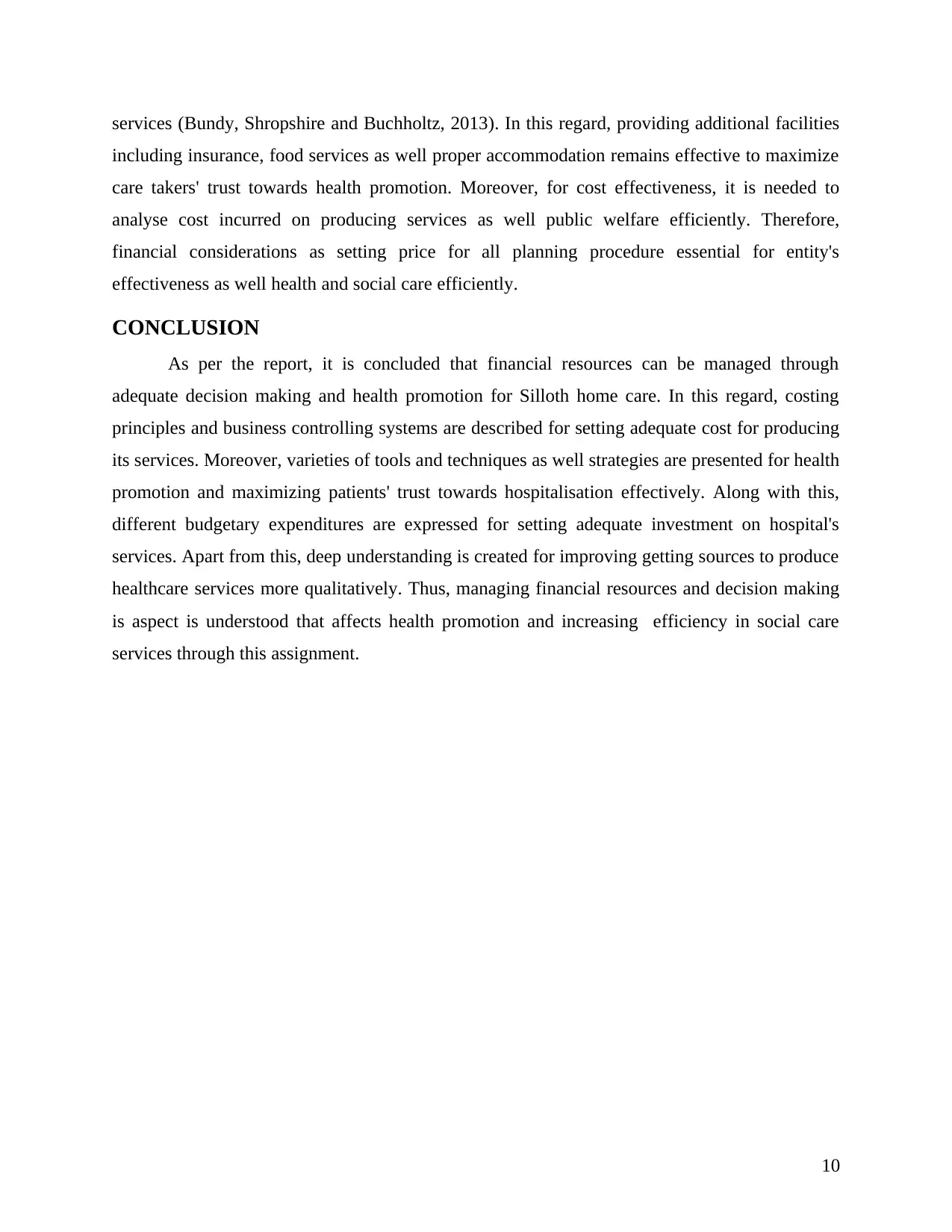
services (Bundy, Shropshire and Buchholtz, 2013). In this regard, providing additional facilities
including insurance, food services as well proper accommodation remains effective to maximize
care takers' trust towards health promotion. Moreover, for cost effectiveness, it is needed to
analyse cost incurred on producing services as well public welfare efficiently. Therefore,
financial considerations as setting price for all planning procedure essential for entity's
effectiveness as well health and social care efficiently.
CONCLUSION
As per the report, it is concluded that financial resources can be managed through
adequate decision making and health promotion for Silloth home care. In this regard, costing
principles and business controlling systems are described for setting adequate cost for producing
its services. Moreover, varieties of tools and techniques as well strategies are presented for health
promotion and maximizing patients' trust towards hospitalisation effectively. Along with this,
different budgetary expenditures are expressed for setting adequate investment on hospital's
services. Apart from this, deep understanding is created for improving getting sources to produce
healthcare services more qualitatively. Thus, managing financial resources and decision making
is aspect is understood that affects health promotion and increasing efficiency in social care
services through this assignment.
10
including insurance, food services as well proper accommodation remains effective to maximize
care takers' trust towards health promotion. Moreover, for cost effectiveness, it is needed to
analyse cost incurred on producing services as well public welfare efficiently. Therefore,
financial considerations as setting price for all planning procedure essential for entity's
effectiveness as well health and social care efficiently.
CONCLUSION
As per the report, it is concluded that financial resources can be managed through
adequate decision making and health promotion for Silloth home care. In this regard, costing
principles and business controlling systems are described for setting adequate cost for producing
its services. Moreover, varieties of tools and techniques as well strategies are presented for health
promotion and maximizing patients' trust towards hospitalisation effectively. Along with this,
different budgetary expenditures are expressed for setting adequate investment on hospital's
services. Apart from this, deep understanding is created for improving getting sources to produce
healthcare services more qualitatively. Thus, managing financial resources and decision making
is aspect is understood that affects health promotion and increasing efficiency in social care
services through this assignment.
10
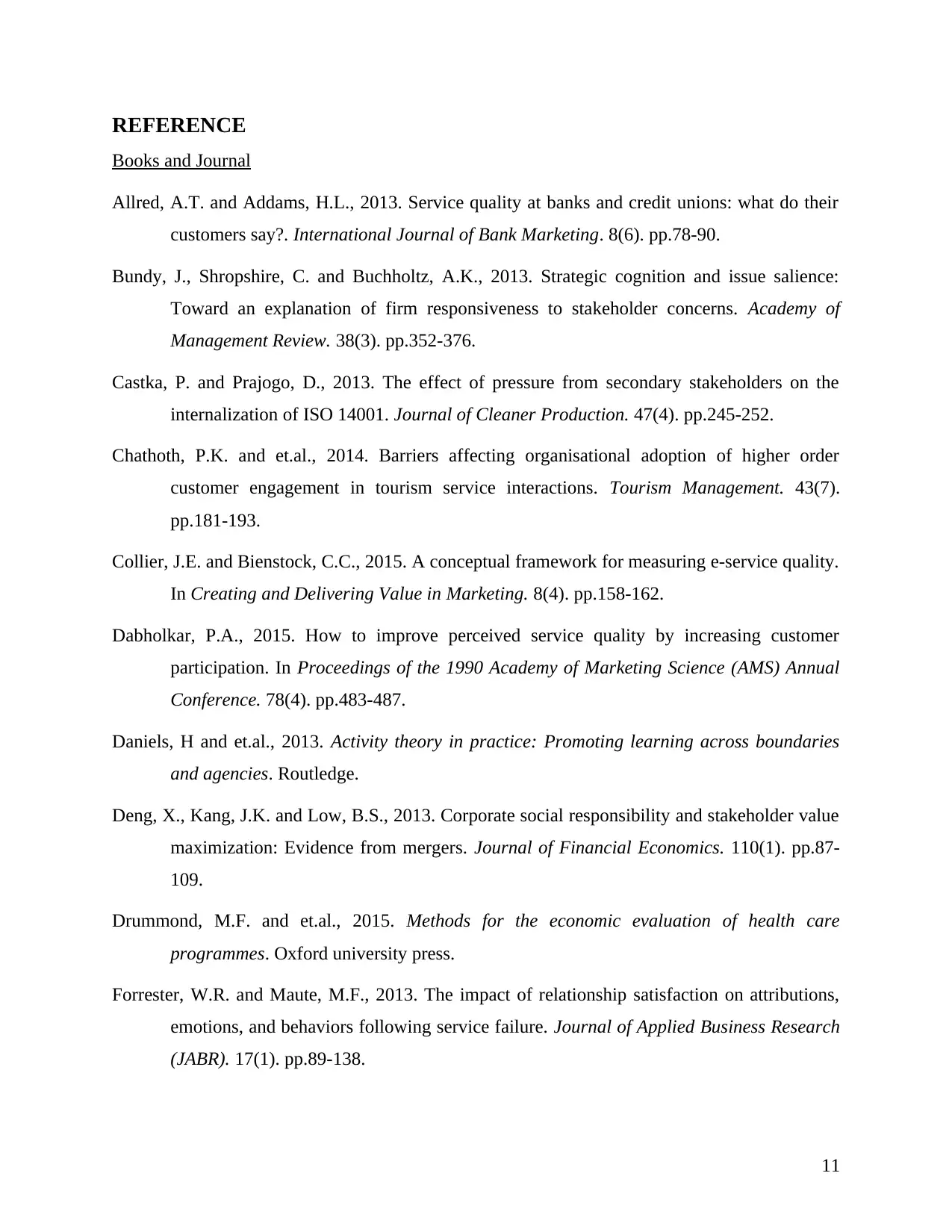
REFERENCE
Books and Journal
Allred, A.T. and Addams, H.L., 2013. Service quality at banks and credit unions: what do their
customers say?. International Journal of Bank Marketing. 8(6). pp.78-90.
Bundy, J., Shropshire, C. and Buchholtz, A.K., 2013. Strategic cognition and issue salience:
Toward an explanation of firm responsiveness to stakeholder concerns. Academy of
Management Review. 38(3). pp.352-376.
Castka, P. and Prajogo, D., 2013. The effect of pressure from secondary stakeholders on the
internalization of ISO 14001. Journal of Cleaner Production. 47(4). pp.245-252.
Chathoth, P.K. and et.al., 2014. Barriers affecting organisational adoption of higher order
customer engagement in tourism service interactions. Tourism Management. 43(7).
pp.181-193.
Collier, J.E. and Bienstock, C.C., 2015. A conceptual framework for measuring e-service quality.
In Creating and Delivering Value in Marketing. 8(4). pp.158-162.
Dabholkar, P.A., 2015. How to improve perceived service quality by increasing customer
participation. In Proceedings of the 1990 Academy of Marketing Science (AMS) Annual
Conference. 78(4). pp.483-487.
Daniels, H and et.al., 2013. Activity theory in practice: Promoting learning across boundaries
and agencies. Routledge.
Deng, X., Kang, J.K. and Low, B.S., 2013. Corporate social responsibility and stakeholder value
maximization: Evidence from mergers. Journal of Financial Economics. 110(1). pp.87-
109.
Drummond, M.F. and et.al., 2015. Methods for the economic evaluation of health care
programmes. Oxford university press.
Forrester, W.R. and Maute, M.F., 2013. The impact of relationship satisfaction on attributions,
emotions, and behaviors following service failure. Journal of Applied Business Research
(JABR). 17(1). pp.89-138.
11
Books and Journal
Allred, A.T. and Addams, H.L., 2013. Service quality at banks and credit unions: what do their
customers say?. International Journal of Bank Marketing. 8(6). pp.78-90.
Bundy, J., Shropshire, C. and Buchholtz, A.K., 2013. Strategic cognition and issue salience:
Toward an explanation of firm responsiveness to stakeholder concerns. Academy of
Management Review. 38(3). pp.352-376.
Castka, P. and Prajogo, D., 2013. The effect of pressure from secondary stakeholders on the
internalization of ISO 14001. Journal of Cleaner Production. 47(4). pp.245-252.
Chathoth, P.K. and et.al., 2014. Barriers affecting organisational adoption of higher order
customer engagement in tourism service interactions. Tourism Management. 43(7).
pp.181-193.
Collier, J.E. and Bienstock, C.C., 2015. A conceptual framework for measuring e-service quality.
In Creating and Delivering Value in Marketing. 8(4). pp.158-162.
Dabholkar, P.A., 2015. How to improve perceived service quality by increasing customer
participation. In Proceedings of the 1990 Academy of Marketing Science (AMS) Annual
Conference. 78(4). pp.483-487.
Daniels, H and et.al., 2013. Activity theory in practice: Promoting learning across boundaries
and agencies. Routledge.
Deng, X., Kang, J.K. and Low, B.S., 2013. Corporate social responsibility and stakeholder value
maximization: Evidence from mergers. Journal of Financial Economics. 110(1). pp.87-
109.
Drummond, M.F. and et.al., 2015. Methods for the economic evaluation of health care
programmes. Oxford university press.
Forrester, W.R. and Maute, M.F., 2013. The impact of relationship satisfaction on attributions,
emotions, and behaviors following service failure. Journal of Applied Business Research
(JABR). 17(1). pp.89-138.
11
Paraphrase This Document
Need a fresh take? Get an instant paraphrase of this document with our AI Paraphraser
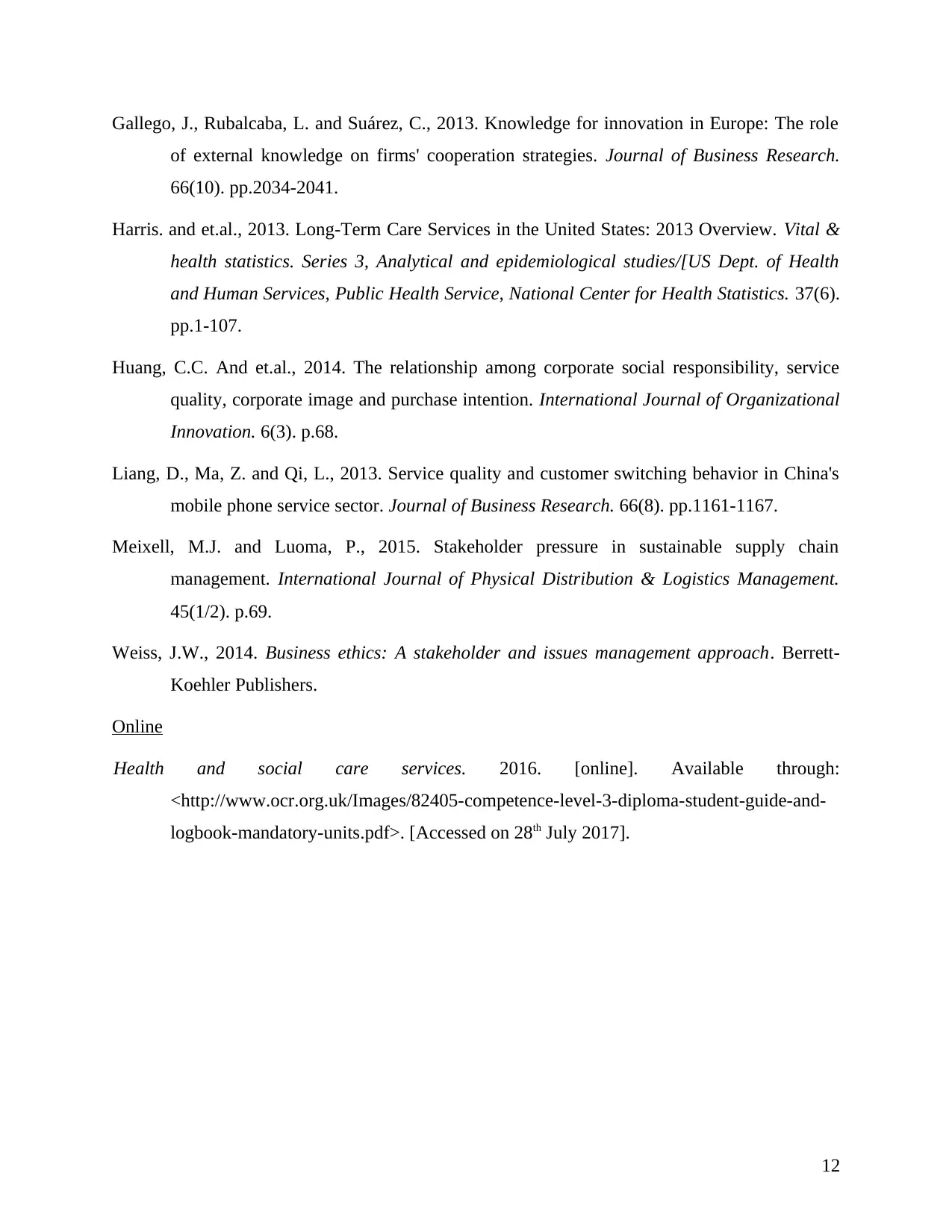
Gallego, J., Rubalcaba, L. and Suárez, C., 2013. Knowledge for innovation in Europe: The role
of external knowledge on firms' cooperation strategies. Journal of Business Research.
66(10). pp.2034-2041.
Harris. and et.al., 2013. Long-Term Care Services in the United States: 2013 Overview. Vital &
health statistics. Series 3, Analytical and epidemiological studies/[US Dept. of Health
and Human Services, Public Health Service, National Center for Health Statistics. 37(6).
pp.1-107.
Huang, C.C. And et.al., 2014. The relationship among corporate social responsibility, service
quality, corporate image and purchase intention. International Journal of Organizational
Innovation. 6(3). p.68.
Liang, D., Ma, Z. and Qi, L., 2013. Service quality and customer switching behavior in China's
mobile phone service sector. Journal of Business Research. 66(8). pp.1161-1167.
Meixell, M.J. and Luoma, P., 2015. Stakeholder pressure in sustainable supply chain
management. International Journal of Physical Distribution & Logistics Management.
45(1/2). p.69.
Weiss, J.W., 2014. Business ethics: A stakeholder and issues management approach. Berrett-
Koehler Publishers.
Online
Health and social care services. 2016. [online]. Available through:
<http://www.ocr.org.uk/Images/82405-competence-level-3-diploma-student-guide-and-
logbook-mandatory-units.pdf>. [Accessed on 28th July 2017].
12
of external knowledge on firms' cooperation strategies. Journal of Business Research.
66(10). pp.2034-2041.
Harris. and et.al., 2013. Long-Term Care Services in the United States: 2013 Overview. Vital &
health statistics. Series 3, Analytical and epidemiological studies/[US Dept. of Health
and Human Services, Public Health Service, National Center for Health Statistics. 37(6).
pp.1-107.
Huang, C.C. And et.al., 2014. The relationship among corporate social responsibility, service
quality, corporate image and purchase intention. International Journal of Organizational
Innovation. 6(3). p.68.
Liang, D., Ma, Z. and Qi, L., 2013. Service quality and customer switching behavior in China's
mobile phone service sector. Journal of Business Research. 66(8). pp.1161-1167.
Meixell, M.J. and Luoma, P., 2015. Stakeholder pressure in sustainable supply chain
management. International Journal of Physical Distribution & Logistics Management.
45(1/2). p.69.
Weiss, J.W., 2014. Business ethics: A stakeholder and issues management approach. Berrett-
Koehler Publishers.
Online
Health and social care services. 2016. [online]. Available through:
<http://www.ocr.org.uk/Images/82405-competence-level-3-diploma-student-guide-and-
logbook-mandatory-units.pdf>. [Accessed on 28th July 2017].
12
1 out of 14
Related Documents
Your All-in-One AI-Powered Toolkit for Academic Success.
+13062052269
info@desklib.com
Available 24*7 on WhatsApp / Email
![[object Object]](/_next/static/media/star-bottom.7253800d.svg)
Unlock your academic potential
© 2024 | Zucol Services PVT LTD | All rights reserved.





